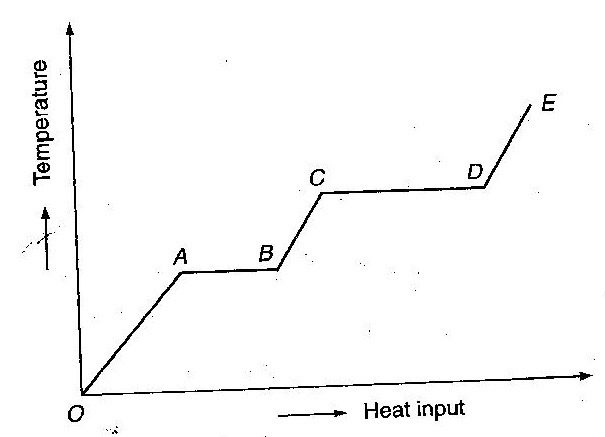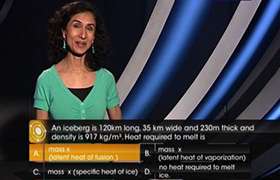CBSE Class 11-science Answered
A solid material is supplied with heat at constant rate. The temperature of the material is changing with the heat input as shown in the figure. Study the graph carefully and answer the following questions.
(i) What do the horizontal regions AB and CD represent?
(ii) If CD= 2AB, what do you infer?
(iii) What does the slope DE represent?
(iv) The slope of OA>the slope of BC. What does this indicate?


Asked by Topperlearning User | 15 Apr, 2015, 11:03: AM
(i) The horizontal portion AB represents the change of state from solid to liquid at constant temperature. This gives the latent heat of fusion. Similarly, CD represents the change of state from liquid to vapour state at constant temperature. This gives the latent heat of vapourisation.
(ii) When CD = 2AB, the latent heat of vapourisation is twice the latent heat of fusion of that substance.
(iii)

Therefore, the slope of DE represents the reciprocal of heat capacity of the vapour state of the substance.
(iv)

Answered by | 15 Apr, 2015, 01:03: PM
Concept Videos
CBSE 11-science - Physics
Asked by Aryan.suthar | 20 Apr, 2019, 09:34: PM
CBSE 11-science - Physics
Asked by Neeraj | 14 Apr, 2019, 10:41: PM
CBSE 11-science - Physics
Asked by Topperlearning User | 04 Jun, 2014, 01:23: PM
CBSE 11-science - Physics
Asked by Topperlearning User | 04 Jun, 2014, 01:23: PM
CBSE 11-science - Physics
Asked by Topperlearning User | 15 Apr, 2015, 10:36: AM
CBSE 11-science - Physics
Asked by Topperlearning User | 15 Apr, 2015, 10:39: AM
CBSE 11-science - Physics
Asked by Topperlearning User | 15 Apr, 2015, 11:03: AM
CBSE 11-science - Physics
Asked by Topperlearning User | 04 Jun, 2014, 01:23: PM
CBSE 11-science - Physics
Asked by Topperlearning User | 04 Jun, 2014, 01:23: PM
CBSE 11-science - Physics
Asked by Topperlearning User | 04 Jun, 2014, 01:23: PM




